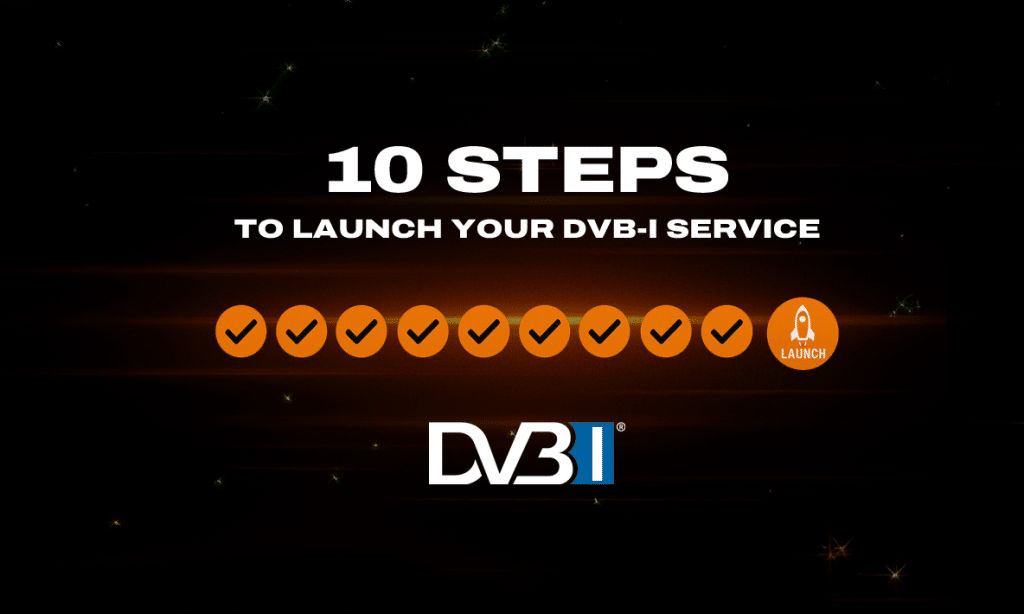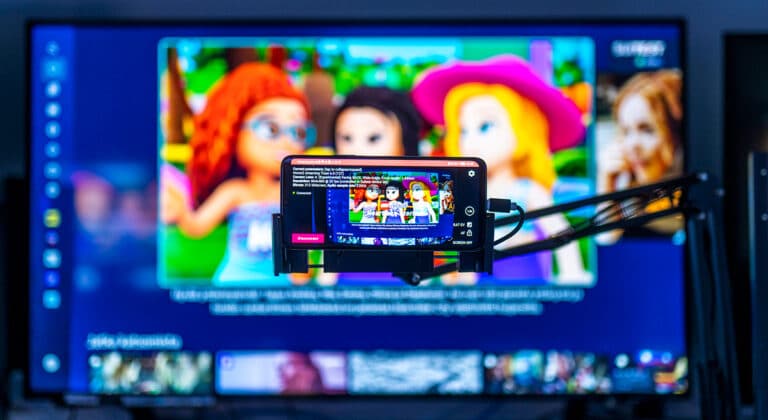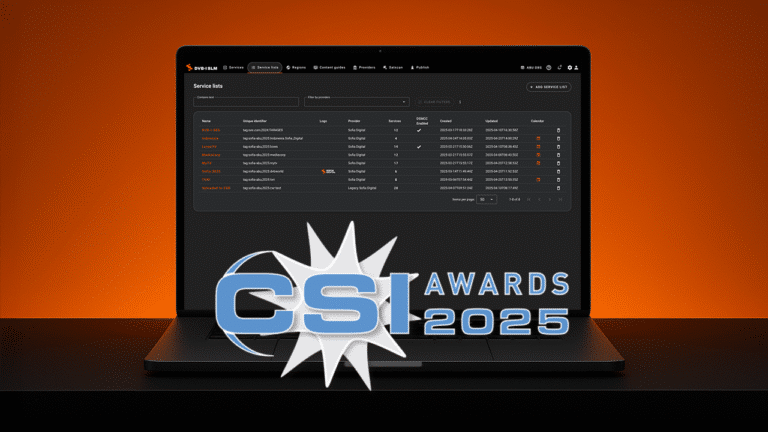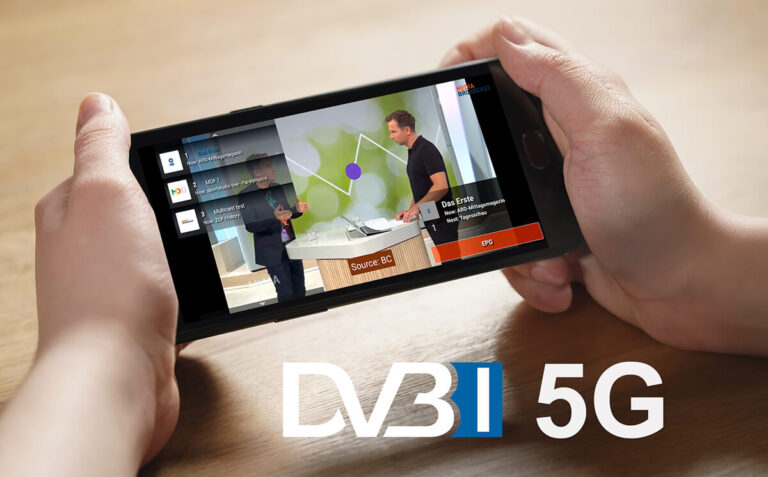
In this article
Rolling out a DVB-I service is a strategic move that enables broadcasters and service providers to deliver television programming seamlessly over broadcast and broadband networks. Here we offer a methodical guide to the successful rollout of DVB-I balancing technical concerns, business requirements, and regulatory compliance.
The 10-step process outlined in this blog entry extends all the way from the creation of the first business case to team formation, technical architecture design, integration of metadata, optimizing the client experience, implementation of security, regulatory compliance, monetization strategy, and future proofing. Each step is a continuation of the one before, offering a seamless sequence that encompasses all the main components of a successful DVB-I rollout.
With this guide, broadcasters can extend their reach beyond traditional distribution channels while maintaining a consistent brand experience, new entrants can leverage standardized frameworks to launch competitive services, and all the providers can benefit from DVB-I’s flexibility to address evolving viewer expectations and technology advancements.
The 10 Steps to Launch Your DVB-I Service
1. Define Your Strategic Business Case
A solid business case is the foundation of any successful DVB-I deployment. Begin by looking at your current market position and opportunities for growth where DVB-I can provide competitive advantage. For established broadcasters operating DVB-T, DVB-S, or DVB-C services, DVB-I is a way to extend beyond the constraints of legacy broadcast infrastructure while keeping one brand experience.
The business case development should project implementation costs and returns. Balance infrastructure requirements, content preparation procedures, and ongoing operational expenses against potential revenue from increased viewership, advertising space, and possible subscription models. DVB-I implementations have been more cost-efficient than maintaining individual broadcast and OTT platforms, particularly as audiences watch more content on multiple devices.
Market studies are needed to understand audience habits and choices in your market areas. As was recorded in DVB-I implementation examples for several European nations, audience fragmentation on both digital and traditional media can be bypassed through the DVB-I single service concept. For instance, the a proof of concept may demonstrate how to reach audiences who lack traditional reception capability, such as apartment dwellers with no DTT capability.
For emerging market players, particularly in the FAST (Free Ad-supported Streaming Television) category, DVB-I provides a benchmark to distribute linear channels at lower infrastructure cost than traditional broadcasting. The business model must consider how DVB-I’s service discovery and electronic program guide functionalities can increase the discoverability of content while competing with incumbents in established broadcasting and streaming players.
Lastly, your business case will need to authoritatively determine if DVB-I will extend from your existing services, create new offerings altogether, or do both. This strategic platform will inform all future implementation choices and obtain necessary stakeholder buy-in and investment.
2. Construct Your Cross-Functional Team
Successful implementation of a DVB-I service requires a group of individuals with different expertise in different fields. As observed in the DVB-I pilot projects across Europe, cross-functional coordination is essential due to the technical, business, and regulatory aspects of implementation.
Begin by identifying technical professionals with experience in broadcast as well as IP delivery systems. These professionals should have knowledge about DVB specifications, managing metadata, network infrastructure, and client application programming. As many presentations indicate, technical teams with experience in both legacy broadcast engineering and web development have been best suited for DVB-I deployments.
Market and business development specialists provide critical input on service positioning, targeting audience, and content acquisition strategy. Their expertise on viewer behaviour and market trends drives the shaping of the DVB-I service to meet genuine audience needs. Business and technical groups collaborate to ensure that technical decisions support business goals rather than setting constraints.
Legal and regulatory awareness is even more important due to the advanced media regulation landscape. Team members with an understanding of the Audiovisual Media Services Directive, European Accessibility Act, and broadcast regulations at country levels provide support in navigating compliance requirements. In European market DVB-I deployments, timely legal expertise engagement has prevented costly alterations down the road in the deployment process.
Content management professionals offer metadata workflow know-how, rights management of material, and programming strategies. Their involvement ensures that the technical deployment sufficiently supports the intended content experience and adheres to rights agreements.
Think of collaborating with experienced DVB-I implementation professionals, particularly for novice organizations entering the standard. In the German national DVB-I pilot, cited herein, collaboration with standards bodies, research organizations, and technology companies accelerated implementation and allowed for positive knowledge sharing.
Finally, establish clear governance arrangements for decision-making with defined roles and responsibilities during the course of implementation. Open cross-team communication and standardized documentation patterns help to keep every aspect of DVB-I deployment aligned with overall project objectives.
3. Value DVB-I's Universal Flexibility
DVB-I is a breakthrough in television delivery with the creation of a technology-neutral layer for service presentation and discovery. The standard enables seamless distribution of linear TV services over any IP-based system without compromising with traditional broadcast networks. This flexibility allows audiences to consume content without needing to be conscious of the delivery mechanism behind it.
The main concept of DVB-I is network neutrality. The standard stipulates that identical content can be delivered over digital terrestrial television (DVB-T/T2), satellite (DVB-S/S2), cable (DVB-C/C2), or IP networks within same service lists. As observed in European deployments, DVB-I enables broadcasters to offer cumulative service lists irrespective of the viewers’ way of connection to their services. From a consumer perspective, this provides an uninterrupted experience in which broadcast and streamed services are not differentiable from each other in program guides.
The DVB-I extensible architecture is especially useful for forward compatibility in implementations. The standard was created with consideration that distribution technologies will still develop, making it possible to include new ways of doing things without breaking the underlying service experience. This has been evidenced by recent technical demonstrations bringing DVB-I together with 5G broadcast functionality and demonstrating how the standard can be flexible to changing distribution technologies.
For conventional broadcasters, DVB-I offers a route to evolve from RF-delivery over a period of time without forcing the viewer to change viewing habits. Service discovery options in DVB-I allow a hybrid method of receiving the same channel via traditional broadcast in the living room but streaming it onto a mobile device elsewhere, presented in a standard-looking interface.
DVB-I’s versatility is also manifest in device support. The standard enables building clients for smart TVs, mobiles, computers, and streaming devices without requiring special hardware beyond internet connectivity. This device independence optimizes reach opportunities while minimizing implementation complexities for both service providers and consumers.
4. Bridge Traditional and IP Delivery with Enhanced Metadata
Metadata is the underlying framework upon which DVB-I implementation is based. Linear TV broadcasting has had established metadata standards, and DVB-I adds to and supersedes these using the TV-Anytime profile optimized for hybrid delivery environments. This achieves backward compatibility with the new features.
The DVB-I standard adopts TV-Anytime metadata schemas for rich program information, content discovery, and personalization capabilities. The structure of the metadata facilitates reuse of current EPG data for broadcast with further enrichment of other fields to allow features like streaming-specific content recommendation and on-demand availability. TV-Anytime profile employed in DVB-I provides standardized forms for describing programs, series, and scheduling information interoperable across delivery platforms.
Use of automated workflows among existing broadcast infrastructure and DVB-I service lists is critical for operational effectiveness. Broadcasters launching DVB-I have established integration points between existing legacy playout and scheduling infrastructure and XML-based service information that is required by DVB-I. Integration yields synchronized program information between broadcast and streaming infrastructures and obliterates manual input of data. The majority of DVB-I implementations use automated conversion software to transform and enhance existing broadcast metadata to the required formats for DVB-I service lists and content guides.
DVB-I metadata functionality is superior to what it customarily offers for standard broadcast data, enabling emerging business models such as FAST channels. These free ad-supported services are augmented by DVB-I’s ability to bring together traditional broadcasters and web-exclusive channels under a single program guide. The metadata model enables FAST operators to distribute linear programming alongside incumbent broadcasters, thus making them more discoverable. This presents an opportunity for content providers to launch targeted linear channels that have lower infrastructure expenses than traditional broadcasting but with the advantage of discoverability provided by DVB-I service lists.
For satellite and cable and legacy DTT operators, DVB-I extends these services’ reach beyond traditional reception. DVB-I builds a metadata bridge that allows these broadcasters to maintain the same degree of brand presence and program detail regardless of what type of reception means viewers have. This integrated approach aids broadcasters in retaining their audiences as viewing behaviour changes and leveraging their tested content and scheduling skills.
5. Design an Economically Priced System Architecture
Technical architecture for an implementation of DVB-I must be designed carefully to balance performance, scalability, and cost. Begin by comparing the relative value of cloud-native and on-premises infrastructure with your existing systems and projected service growth. In stations with extensive pre-existing infrastructure, a hybrid setup often represents the most cost-effective route of transition.
Cloud-native components often include service lists registries, content guides, and stream package systems. They leverage cloud elasticity of resources so that capacity increases with audience. On-prem systems remain fit for ingest, playout, and first-stage encoding, particularly when paired with existing broadcast facilities. The optimum architecture minimizes duplicate systems and ensures guaranteed delivery on both the broadcast and the IP network.
Implementation costs can be managed through containerization and microservices technologies. These technologies enable maximum resource utilization and seamless scaling of individual system components. For example, server packaging can be scaled independently of content management systems based on actual usage patterns. This approach has proven to be more cost-effective than monolithic systems in most DVB-I deployments in Europe.
Plan redundancy needs carefully to ensure service continuity without inducing redundant duplication. Geographically spreading cloud resources offers regional outage protection, and content delivery networks (CDNs) reduce bandwidth costs and improve viewer experience. The system design should include monitoring capabilities on all components to quickly identify and resolve likely issues before their effect on service quality. For video quality metrics, existing systems fit well to a DVB-I platform.
6. Deploy Multi-Device Client Experiences
It is in the client’s experience that individuals directly interact with your DVB-I service, therefore, it is a prerequisite to plan for device diversity. DVB-I clients must be able to handle various screen dimensions, processing capacities, and connectivity conditions in order to provide consistent access over televisions, smartphones, tablets, and computers.
Adaptive design techniques enable clients to automatically transform user interfaces based on device capabilities. This can involve responsive layouts that reorganize material for different screen sizes and optimized navigation patterns for small screens. The DVB-I client should provide a consistent experience while maximizing device features where appropriate, like touch input on portable devices or remote control optimization on TV.
Intelligent switching between signals is a significant feature in hybrid reception environments. Demonstrated through examples like the Sofia Digital AndroidTV app, customers can automatically switch between broadcast and broadband feeds based on available signals with differing quality. Further down the road, this functionality ensures continued watching as a viewer moves out of the home into a different set of reception environments, for example switching between WLAN, 5G Broadcast or DVB-NIP delivery methods.
Testing on a representative set of target devices is essential to guarantee compatibility and performance. Be particularly mindful of transitional events such as channel changes, which should be effectively instantaneous independent of the underlying delivery infrastructure. Client software needs to be designed for periodic update in order to provide support for new device capabilities and evolving standards.
7. Secure Content and Infrastructure
Content protection and security are inherent requirements of any DVB-I deployment. The hybrid character of DVB-I across broadcast and IP delivery necessitates an end-to-end security solution that protects against threats throughout the delivery chain.
Content protection strategies must be adapted to the DVB-I environment, in which the same content can be delivered in multiple paths with varying security concerns. For broadcast elements, conventional conditional access systems will still be suitable, whereas IP-delivered content usually calls for digital rights management (DRM) systems. In deploying DVB-I, consider whether a multi-DRM strategy is required to accommodate your target market’s range of devices, weighing protection needs against implementation overhead.
DRM implementation needs to maintain viewer experience while providing required content protection. It includes restricting authentication processes, supporting smooth playback shifts, and supporting services like time-shifting without security breaches. The DRM strategy also needs to include offline viewing scenarios wherever necessary, particularly for mobile devices with intermittent connectivity.
Aside from content protection, a complete infrastructure security is required to protect the service integrity. This entails securing the production and distribution chain, safeguarding metadata and service information against unauthorized modification, and implementing access controls to management systems. Regular security audits should identify and fix potential vulnerabilities before they can be used.
Protection against distributed denial-of-service attack is particularly important to IP-delivered pieces. Mitigation should be obtainable from CDN partners, but management systems and origin servers may need additional action. Incident response mechanisms should be included in the security plan in order to keep the service accessible regardless of security events.
8. Ensure Compliance with Regulatory Needs
Compliance has become more complex for media services, with multiple frameworks regulating DVB-I implementations in different markets. It is important to be aware of and handle these requirements early in the implementation process to prevent costly changes later on.
The Audiovisual Media Services Directive (AVMSD) sets minimum requirements for content prominence and service information across European markets. Among some of the core issues to take into account are protection of children, accessibility of programming, and provision of sufficient service information. Specific consideration in DVB-I implementations needs to be for prominence, for services of general interest, potentially affecting service list display and service ordering.
The European Accessibility Act (EAA) renders accessibility features mandatory for digital services, and the deadline for compliance is June 2025. Subtitling, audio description, and spoken subtitles should be supported by DVB-I implementations for users with disabilities. The TV-Anytime metadata framework of the standard provides ways to signal the availability of these accessibility features so that clients can provide appropriate options to viewers.
DVB-I’s service and content description standardization offers an advantage in regulatory compliance. The standard supports fields for age ratings, content warnings, and accessibility information that can be presented uniformly across different client implementations. Standardization simplifies the compliance with requirements varying by jurisdiction and provides a consistent viewer experience.
Working closely with national regulatory authorities to understand market-specific interpretations of broader frameworks like the AVMSD and EAA is essential. It is noted in pilot projects across Europe that engaging regulators early allows the implementation methodology to reflect the regulatory expectations while still allowing innovation within the regulatory framework.
9. Monetize Through Advanced Advertising
Advertising is still one of the major sources of income for most broadcasters, and DVB-I provides for richer advertising features that grow monetization opportunity. The DVB Targeted Advertising (DVB-TA) specifications enable a standardized model for delivering addressed advertising in and around linear programming over both broadcast and IP distribution.
DVB-TA deployment begins with the insertion of the correct signaling in the content stream to identify advertising insertion opportunities. For broadcast components, it typically uses SCTE-35 markers, while IP-delivered content may use SCTE-35 or manifest-based signaling. This one signaling solution makes ad insertion uniform across delivery systems while supporting server-side and client-side insertion technologies.
Client-side insertion ad functionality in DVB-I applications provides targeting and measurement advantages. The client can consider device characteristics, viewing context, and viewer interest while initiating ad requests and thereby make them more relevant and effective. Client-side insertion also enables interactive features of advertising that are particularly invaluable for connected devices like smart TVs and smartphones.
Development of a privacy-friendly data strategy is required with increasing regulatory focus on safeguarding user data. The advertising strategy must balance targeting opportunities and privacy legislation such as the General Data Protection Regulation (GDPR). It entails the application of proper consent practices, data minimization techniques, and transparent privacy policies.
Measurement and reporting capability needs to be built to have an impact for advertisers without infringing on user privacy. Combining traditional broadcast measurement with digital metrics gives a more comprehensive picture of ad performance than either measurement in isolation. This comprehensive measurement approach has been valuable in existing DVB-I rollouts, providing insights into cross-platform viewing behaviour that were not readily accessible previously.
10. Launch, Monitor, and Future-Proof Your Service
The final phase of your DVB-I implementation process is to move from planning to action with a long-term sustainability focus. Begin with controlled technical trials with a small audience to experiment with both your technical deployment and market assumptions. This allows you to identify and fix any potential problems before large-scale rollout while gaining valuable user feedback.
After launch, put in place full-service monitoring systems that monitor not only technical performance metrics but also viewer patterns of engagement. New analytics platforms can assist with knowing what works best on what devices, when audiences prefer broadcast over broadband delivery, and how they interact with your service interface. This data-driven strategy allows ongoing optimization based on reality rather than assumption.
The true strength of DVB-I is its look-ahead architecture. As you go live with your initial service, be adaptive enough to embrace emerging technologies like 5G Broadcast, which will significantly broaden your mobile footprint. The flexible architecture of the standard allows you to add new delivery mechanisms and introduce features without affecting existing services or requiring complete redevelopment.
Keep in mind that DVB-I is all about dismantling the old silos among delivery mechanisms. Your success will be predicated on delivering a smooth experience where viewers care only about content and not how it gets there. This focus on the viewer, combined with constant technical advancement, sets your DVB-I service up for long-term success in a media landscape that is constantly changing.
Conclusion
The launch of a DVB-I service is both a technical advance and a business initiative for media businesses. As broadcast models evolve, DVB-I provides a standardized platform that brings terrestrial, satellite, cable, and IP delivery together while providing an integrated experience for consumers.
The 10-step approach contained in this blog post centers on an evenly balanced strategy of implementation based on business needs, technical elements, and regulations. From designing effective business cases to creating future-proof systems, each step hinges on the previous one to establish an overall plan of implementation.
Recent developments within the DVB-I ecosystem show the growing adoption of the standard across Europe. Pilot schemes and deployments are underway, and revisions to the specification continue to address industry needs. The March 2025 edition of DVB Scene magazine reported new pilots in Spain, deployments in Ireland, and intentions to integrate DVB-I with 5G broadcast technology as evidence of the ongoing development and industry support for the standard. In Germany, the first phases of the Pilot are concluded, and a round table has been established to solve the remaining steps in making DVB-I production use a reality.
For broadcasters, DVB-I offers a way to expand reach beyond traditional reception technologies while maintaining a consistent brand experience. For new market entrants, particularly in the FAST segment, the standard provides a foundation to broadcast linear channels with lower infrastructure costs than traditional broadcasting. For all providers, the flexibility of DVB-I ensures adaptability to changing viewer behaviour and technology evolution.
With ongoing fragmentation of media consumption across devices and platforms, DVB-I’s ability to provide a homogeneous, device-agnostic experience positions it as a key enabling technology for the future of television delivery. By following the structured implementation approach described in this guide, organizations can steer clear of the dangers of deploying DVB-I while achieving the greatest potential benefits of the standard.
References
- DVB-I Specification (A177). (2024). DVB Project.
Retrieved from https://dvb.org/?standard=service-discovery-and-programme-metadata-for-dvb-i - Implementation Guidelines for DVB-I (A184). (2024). DVB Project.
Retrieved from https://dvb.org/?standard=implementation-guidelines-for-dvb-i - DVB-TA Specifications (A178). (2020). DVB Project.
Retrieved from https://dvb.org/news/dvb-targeted-advertising-standards-published-by-etsi/ - European Accessibility Act (EAA). (2019). European Commission.
Retrieved from https://commission.europa.eu/strategy-and-policy/policies/justice-and-fundamental-rights/disability/union-equality-strategy-rights-persons-disabilities-2021-2030/european-accessibility-act_en - Audiovisual Media Services Directive (AVMSD). (2018). European Commission.
Retrieved from https://digital-strategy.ec.europa.eu/en/policies/audiovisual-regulators - DVB-I Timeline. (2024). DVB Project.
Retrieved from https://dvb-i.tv/timeline/ - DVB Scene 65: DVB-I Pilot in Spain. (2025). DVB Project.
Retrieved from https://dvb.org/news/dvb-scene-65-dvb-i-pilot-in-spain-dvb-compliance-and-testing-codec-developments/ - DVB World 2025 Conference Proceedings. (2025). DVB Project.
Retrieved from https://dvbworld.org/ - DVB-I Service Delivery over 5G Systems; Deployment Guidelines. (2023). DVB Project.
Retrieved from https://dvb.org/?standard=dvb-i-service-delivery-over-5g-systems-deployment-guidelines - Commercial Requirements for Targeted Advertising in DVB-I. (2022). DVB Project.
Retrieved from https://dvb.org/wp-content/uploads/2022/11/C103_Commercial_Requirements-for-Targeted-Advertising-in-DVB-I-services-delivered-via-DVB-DASH.pdf - Understanding Free Ad-supported Streaming Television. (2025). Various sources.
Retrieved from industry publications and reports. - Accessibility Implementation Guidelines for DVB-I. (2025). DVB Project.
Retrieved from https://dvb.org/news/dvb-publishes-accessibility-implementation-guidelines-for-dvb-i/





